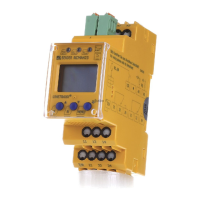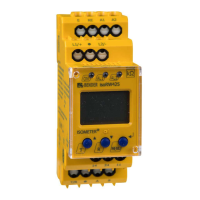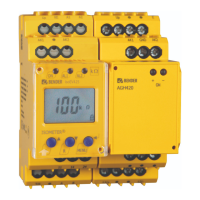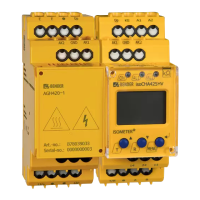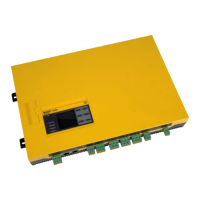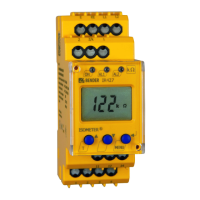Function
2 Function
2.1 Intended use
The AC and pulsed DC sensitive residual current monitor RCM420 (Type A) from Bender is designed for fault
and residual current monitoring in earthed power supply systems (TN/TT systems) where an alarm is to be
activated in the event of a fault, but disconnection must be prevented. In addition, the device can be used to
monitor single conductors, such as PE conductors, N-PE connections and PE-PAS connections.
Two separately adjustable response ranges I
Δ1
and I
Δ2
allow to distinguish between prewarning and main
alarm (I
Δ1
= 50…100 % of the set response value I
Δ2
).
In order to meet the requirements of the applicable standards, customised parameter settings must be made
on the equipment in order to adapt it to local equipment and operating conditions. Please heed the limits of
the range of application indicated in the technical data. Any use other than that described in this manual is
regarded as improper.
2.2 Device features
•
AC and pulsed DC sensitive residual current monitor Type A according to DIN EN 62020
•
Adjustable switching hysteresis
•
R.m.s. value measurement
•
Starting delay, response delay and delay on release
•
Measured value display via multi-functional LC display
•
Alarm indication via LEDs (AL1, AL2) and changeover contacts (K1, K2)
•
N/C operation or N/O operation selectable
•
Password protection against unauthorized parameter changing
•
Fault memory function can be switched off
•
CT connection monitoring
2.3 Function
Once the supply voltage U
S
is applied, the starting delay is activated. Measured values changing during this
time do not influence the switching state of the alarm relays.
Residual current measurement takes place via an external measuring current transformer of the CTAC…, WR…
or WS… series.
The currently measured value is shown on the LC display. In this way any changes, for example when circuits
are connected to the system, can be recognized easily.
If the measured value exceeds one or both response values, the response delays t
on1/2
start running. Once the
response delay t
on1/2
has elapsed, the K1/ K2 alarm relays switch and the alarm LEDs AL1/AL2 light up.
If the residual current falls below the release value (response value minus hysteresis), the delay on release t
off
begins. Once the release delay t
off
has elapsed, the alarm relays return to their original state and the alarm LEDs
AL1/AL2 go out. If the fault memory is activated, the alarm relays remain in the alarm state and the LEDs light
until the reset button is pressed or until the supply voltage is interrupted.
The device function can be tested using the test button. The parameterization of the device can be carried out
via the LC display and the function keys integrated in the front plate and can be password-protected.
8 RCM420_D00057_06_M_XXEN/12.2023

